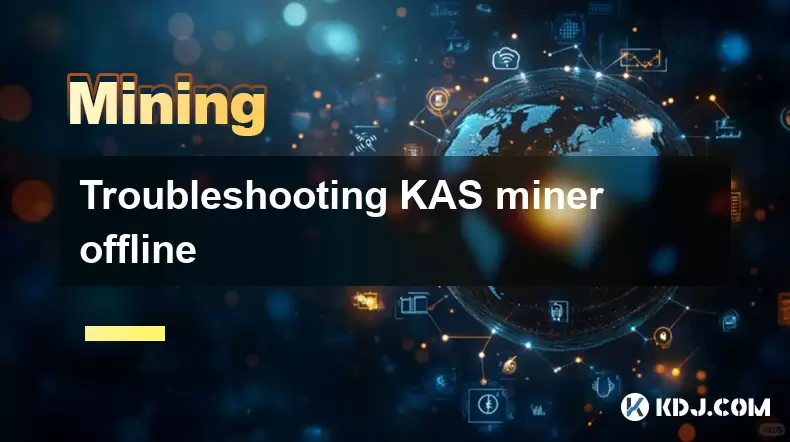-
 bitcoin
bitcoin $122090.672462 USD
1.59% -
 ethereum
ethereum $4493.758974 USD
0.56% -
 xrp
xrp $3.033145 USD
0.65% -
 tether
tether $1.000629 USD
0.00% -
 bnb
bnb $1169.854250 USD
7.07% -
 solana
solana $230.954786 USD
-0.19% -
 usd-coin
usd-coin $0.999785 USD
0.00% -
 dogecoin
dogecoin $0.256108 USD
-1.12% -
 tron
tron $0.342333 USD
-0.12% -
 cardano
cardano $0.859632 USD
-0.10% -
 hyperliquid
hyperliquid $48.932146 USD
-2.25% -
 chainlink
chainlink $22.345466 USD
-1.29% -
 ethena-usde
ethena-usde $1.000217 USD
-0.03% -
 avalanche
avalanche $31.203456 USD
1.93% -
 sui
sui $3.579145 USD
1.05%
Troubleshooting KAS miner offline
A KAS miner going offline can stem from network, config, or hardware issues—check connections, verify settings, and ensure proper cooling and updated software.
Jul 28, 2025 at 11:07 pm

Understanding the KAS Miner Offline Issue
When a KAS miner goes offline, it can significantly disrupt mining operations and reduce potential earnings. The term 'offline' typically means that the mining software or hardware is no longer communicating with the mining pool or the network. This could stem from network instability, configuration errors, or hardware malfunctions. Identifying the root cause is essential for restoring mining functionality. Common indicators include the miner not appearing in the pool dashboard, hash rate dropping to zero, or repeated connection timeouts. The first step is to confirm whether the issue is localized to a single device or affects multiple miners in a rig setup.
Checking Network Connectivity
Network problems are among the most frequent causes of a KAS miner going offline. Begin by verifying the physical connection between the miner and the router or switch. Ensure that Ethernet cables are securely plugged in and not damaged. If using Wi-Fi, consider switching to a wired connection for improved stability. To test connectivity:
- Ping the mining pool’s server IP address from the same network
- Use
ping pool.kaspa.orgin the command line if the pool supports ICMP - Confirm that the router is assigning a valid IP address to the miner via DHCP
- Check for IP conflicts or firewall rules blocking outbound traffic on ports used by the KAS miner (typically port 16171 for KASPA)
If the miner is on a local network, log into the router’s admin panel and locate the device by its MAC address to ensure it has an active IP. Disabling any aggressive firewall or antivirus software temporarily can help isolate whether network filtering is the culprit.
Verifying Miner Configuration Settings
Incorrect configuration is a leading reason for KAS miner disconnections. Most KASPA miners use configuration files (such asconfig.txtor JSON-based files) that define pool URLs, wallet addresses, and worker names. A single typo can prevent the miner from authenticating or connecting. Open the configuration file and validate the following: - The pool URL is correct (e.g.,
stratum+tcp://pool.kaspa.org:16171) - The wallet address is valid and starts with
kaspa: - The worker name is properly formatted (e.g.,
rig001) - There are no extra spaces or special characters in the fields
For command-line miners like
kamdorgominer, double-check the startup command. Example:./gominer -P stratum+tcp://pool.kaspa.org:16171 -u kaspa:youraddress.worker1 -p xEnsure the executable has execute permissions and runs without syntax errors. Reboot the miner after making changes to allow the new configuration to take effect.
Monitoring Hardware and System Resources
Even with proper network and configuration settings, hardware issues can force a KAS miner offline. Overheating, insufficient power supply, or GPU/CPU failures may cause the miner to crash or halt operations. Use built-in monitoring tools or third-party software to assess: - GPU temperature (should remain below 85°C under load)
- Power supply unit (PSU) stability (check for flickering or shutdowns)
- Fan speeds and airflow in the mining rig
- System logs for kernel panics or driver crashes
For ASIC-based KAS miners, consult the device’s web interface or LCD panel for error codes. Reset the device if it reports hardware faults. If using a PC-based rig, ensure the operating system is updated and drivers (especially GPU drivers) are compatible with the mining software. Running the miner in a minimal Linux environment (like HiveOS or RaveOS) can reduce system overhead and improve reliability.
Updating Miner Software and Firmware
Outdated software can lead to compatibility issues with the KASPA network or mining pools. Always ensure you are running the latest version of the mining software. Check the official GitHub repository or community forums for updates. For example: - Visit the gominer GitHub page and download the newest release
- Replace the old binary and reconfigure if necessary
- For FPGA or ASIC miners, update the firmware through the manufacturer’s portal
Before updating, back up the current configuration. After installation, restart the miner and observe the console output for successful connection messages. Some updates may change default ports or require new command-line arguments. Review the changelog to anticipate such changes.
Testing with Alternate Pools and Local Mining
If the miner remains offline despite troubleshooting, test connectivity using an alternative mining pool. Switch the pool URL in the configuration to a backup option such askaspapool.comorluckypool.org. This helps determine if the issue lies with the primary pool’s server status. Monitor the pool’s website or Discord channel for outage announcements.For advanced users, consider setting up a local stratum proxy or attempting direct node connection. This involves running a full KASPA node and connecting the miner directly to it using:
-P stratum+tcp://localhost:16171This method bypasses third-party pools and can isolate whether the problem is network-related or software-based. Ensure the local node is fully synced before attempting this.
Reviewing Pool and Wallet Status
Even if the miner appears to be running, it may not register on the pool dashboard due to wallet or worker authentication issues. Log into the mining pool’s website and check: - Whether the wallet address is recognized
- If any rejected shares are reported
- The last seen timestamp for the worker
Some pools require wallet addresses to be registered or whitelisted. Confirm that your wallet has been used in a transaction before, as some pools reject unused addresses. If using a paper wallet or cold storage, ensure it supports receiving funds. Generate a new worker name and test with it to rule out naming conflicts.
Frequently Asked Questions
Q: Why does my KAS miner show 0.00 KH/s even though it’s online?A: A hash rate of 0.00 KH/s usually indicates that the miner is connected to the pool but not receiving work or failing to submit shares. Check the console logs for messages like 'rejected share' or 'stale share.' Ensure the GPU or ASIC is properly detected and not throttling due to heat or power limits. Reboot the miner and verify that the mining algorithm (kHeavyHash) is supported by your hardware.
Q: Can a firewall block my KAS miner from connecting?A: Yes, firewalls can block outbound connections on port 16171, which is used by KASPA mining pools. Ensure that your firewall or router allows traffic on this port. On Windows, add the miner executable to the allowed apps list. On Linux, use
ufw allow 16171/tcpor configure iptables accordingly. Disable any intrusive security suites temporarily to test.Q: How do I know if my KAS wallet address is valid?A: A valid KASPA wallet address starts with
kaspa:followed by 47 to 50 alphanumeric characters. Use a KASPA block explorer (like explorer.kaspa.org) and enter your address. If it returns a balance or transaction history, it’s valid. Avoid using exchange deposit addresses unless explicitly supported. Generate addresses using official wallets like KDX or Trezor Suite.Q: What should I do if my miner keeps disconnecting every few minutes?A: Frequent disconnections often point to unstable network conditions or pool overload. Try switching to a geographically closer pool server. Reduce network load by disconnecting unused devices. In the miner configuration, add a reconnect delay parameter if supported. Monitor bandwidth usage—mining requires consistent low-latency connections. Consider using a dedicated internet line for mining operations.
Disclaimer:info@kdj.com
The information provided is not trading advice. kdj.com does not assume any responsibility for any investments made based on the information provided in this article. Cryptocurrencies are highly volatile and it is highly recommended that you invest with caution after thorough research!
If you believe that the content used on this website infringes your copyright, please contact us immediately (info@kdj.com) and we will delete it promptly.
- BlockDAG, DOGE, HYPE Sponsorship: Crypto Trends Shaping 2025
- 2025-10-01 00:25:13
- Deutsche Börse and Circle: A StableCoin Adoption Powerhouse in Europe
- 2025-10-01 00:25:13
- BlockDAG's Presale Buzz: Is It the Crypto to Watch in October 2025?
- 2025-10-01 00:30:13
- Bitcoin, Crypto, and IQ: When Genius Meets Digital Gold?
- 2025-10-01 00:30:13
- Stablecoins, American Innovation, and Wallet Tokens: The Next Frontier
- 2025-10-01 00:35:12
- NBU, Coins, and Crypto in Ukraine: A New Yorker's Take
- 2025-10-01 00:45:14
Related knowledge

The difference between staking and mining
Sep 24,2025 at 05:18am
Understanding Staking in the Cryptocurrency Ecosystem1. Staking involves holding funds in a cryptocurrency wallet to support the operations of a block...

How to participate in testnet mining?
Sep 22,2025 at 09:18am
Understanding Testnet Mining in the Crypto Ecosystem1. Testnet mining is a method used by blockchain developers to simulate real-world conditions on a...

How to dispose of abandoned mining machines?
Sep 19,2025 at 08:19pm
Assessing the Condition of Abandoned Mining Rigs1. Begin by inspecting each mining machine for visible damage, corrosion, or missing components. Machi...

How to identify high-quality mining pools?
Sep 21,2025 at 03:19pm
Reputation and Track Record1. A mining pool’s reputation is built over time through consistent performance and transparency. Pools that have operated ...

Advantages of decentralized mining pools
Sep 20,2025 at 04:36pm
Enhanced Security and Resistance to Censorship1. Decentralized mining pools operate on blockchain-based smart contracts, eliminating the need for a ce...

What is mining machine overclocking?
Sep 21,2025 at 07:19pm
Understanding Mining Machine Overclocking1. Mining machine overclocking refers to the process of increasing the operating frequency of a cryptocurrenc...

The difference between staking and mining
Sep 24,2025 at 05:18am
Understanding Staking in the Cryptocurrency Ecosystem1. Staking involves holding funds in a cryptocurrency wallet to support the operations of a block...

How to participate in testnet mining?
Sep 22,2025 at 09:18am
Understanding Testnet Mining in the Crypto Ecosystem1. Testnet mining is a method used by blockchain developers to simulate real-world conditions on a...

How to dispose of abandoned mining machines?
Sep 19,2025 at 08:19pm
Assessing the Condition of Abandoned Mining Rigs1. Begin by inspecting each mining machine for visible damage, corrosion, or missing components. Machi...

How to identify high-quality mining pools?
Sep 21,2025 at 03:19pm
Reputation and Track Record1. A mining pool’s reputation is built over time through consistent performance and transparency. Pools that have operated ...

Advantages of decentralized mining pools
Sep 20,2025 at 04:36pm
Enhanced Security and Resistance to Censorship1. Decentralized mining pools operate on blockchain-based smart contracts, eliminating the need for a ce...

What is mining machine overclocking?
Sep 21,2025 at 07:19pm
Understanding Mining Machine Overclocking1. Mining machine overclocking refers to the process of increasing the operating frequency of a cryptocurrenc...
See all articles










































































